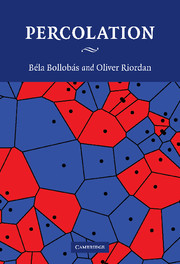Book contents
- Frontmatter
- Contents
- Preface
- 1 Basic concepts and results
- 2 Probabilistic tools
- 3 Bond percolation on ℤ2 – the Harris–Kesten Theorem
- 4 Exponential decay and critical probabilities – theorems of Menshikov and Aizenman & Barsky
- 5 Uniqueness of the infinite open cluster and critical probabilities
- 6 Estimating critical probabilities
- 7 Conformal invariance – Smirnov's Theorem
- 8 Continuum percolation
- Bibliography
- Index
- List of notation
7 - Conformal invariance – Smirnov's Theorem
Published online by Cambridge University Press: 05 June 2012
- Frontmatter
- Contents
- Preface
- 1 Basic concepts and results
- 2 Probabilistic tools
- 3 Bond percolation on ℤ2 – the Harris–Kesten Theorem
- 4 Exponential decay and critical probabilities – theorems of Menshikov and Aizenman & Barsky
- 5 Uniqueness of the infinite open cluster and critical probabilities
- 6 Estimating critical probabilities
- 7 Conformal invariance – Smirnov's Theorem
- 8 Continuum percolation
- Bibliography
- Index
- List of notation
Summary
The celebrated ‘conformal invariance’ conjecture of Aizenman and Langlands, Pouliot and Saint-Aubin [1994] states, roughly, that if ∧ is a planar lattice with suitable symmetry, and we consider percolation on ∧ with probability p = pc(∧), then as the lattice spacing tends to zero certain limiting probabilities are invariant under conformal maps of the plane ℝ2 ≅ ℂ. This conjecture has been proved for only one standard percolation model, namely independent site percolation on the triangular lattice. The aim of this chapter is to present this remarkable result of Smirnov [2001a; 2001b], and to discuss briefly some of its consequences.
In the next section we describe the conformal invariance conjecture, in terms of the limiting behaviour of crossing probabilities, and present Cardy's explicit prediction for these conformally invariant limits. In Section 2, we present Smirnov's Theorem and its proof; as we give full details of the proof, this section is rather lengthy. Finally, we shall very briefly describe some consequences of Smirnov's Theorem concerning the existence of certain ‘critical exponents.’
Crossing probabilities and conformal invariance
Throughout this chapter we identify the plane ℝ2 with the set ℂ of complex numbers in the usual way. A domain D ⊂ ℂ is a non-empty connected open subset of ℂ. If D and D′ are domains, then a conformal map from D to D′ is a bijection f : D → D′ which is analytic on D, i.e., analytic at every point of D. Note that f-1 is then analytic on D′.
- Type
- Chapter
- Information
- Percolation , pp. 178 - 239Publisher: Cambridge University PressPrint publication year: 2006



